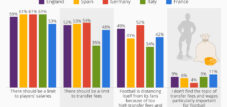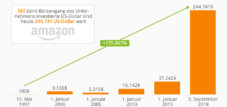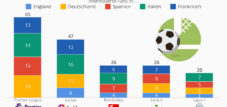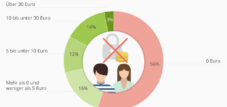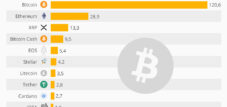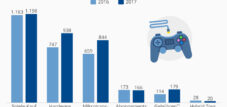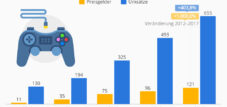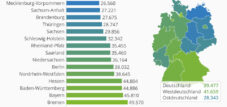Everything you always wanted to know digitally about football
Language selection 📢
Published on: August 22, 2018 / update from: September 9, 2018 - Author: Konrad Wolfenstein
+++ TV & apps are the most popular football information channels +++ Football is preferred on free TV +++ Women's thing football? +++ Current sports studio and sports show are the most popular football formats +++ Football advertising machine +++ Who earns money from the jersey? +++ King football rules the world +++ Krombacher is the most advertised +++ Billionaire reach brings FIFA billions +++ The World Cup trophy is becoming more and more valuable +++ FCB is worth around $3.1 billion ++ + Where the fans stand politically +++ FCB and RBL are the most hated clubs +++ FCB and BVB are the most popular clubs +++ Bayern and Hoffenheim in an image comparison +++ There are Bayern and Dortmund fans everywhere +++ Lucrative ones Stadium names +++
TV & Apps are the most popular football information channels

Television and apps are the most common channels for football information. This comes from the Statista European Football Benchmark, for which 3,030 people interested in football were surveyed. Apparently it's a real old-school medium: 17 percent use videotext to keep up to date with what's happening in the Bundesliga.
Football is preferably on free TV
When the Bundesliga starts the new season this weekend, fans will have to be prepared for some changes. In addition to new kick-off times - the first league will also play on Monday for the first time - the redesign of the TV broadcasts in particular caused irritation in advance. For the first time since Arena's brief interlude in the 2006/2007 season, not all games will be shown live on the pay channel Sky.
Since the DFL, in consultation with the Federal Cartel Office, committed itself not to allocate all live TV rights to the same provider when re-allocating the rights, 40 games from the first league will be broadcast exclusively by Eurosport, which can only be seen with a paid subscription. However, what caused an uproar among Sky customers probably doesn't matter to most football fans: As the specialist magazine Horizont found out in a survey, the majority of fans follow the Bundesliga on free TV or on the radio anyway.

Football for women?
In the classic distribution of roles, football is a man's job: drinking beer, talking shop, going to the stadium. However, this picture seems to be changing; according to a recent survey by the market research institute mafo.de, young men in particular are losing interest in the Bundesliga. For women, however, it increases across all age groups.
A total of 30 percent of women said that they had become more interested in the Bundesliga in the past three years. For men it was only 21.9 percent. At 29.2 percent, however, interest has decreased. It is primarily young men between the ages of 18 and 30 who agree with this statement. Among women, interest has only decreased by 19.5 percent, as the Statista graphic shows. Overall, interest remained unchanged among half of football fans, whether male or female.

Current sports studio and sports show are the most popular football formats
Current sports studio and sports show are the most popular TV programs among those interested in football, according to Statista European Football Benchmark. Bundesliga is currently followed by Sport1 with a viewer share of 34 percent in the past twelve months. The broadcaster is also represented with two other programs - pure Bundesliga and a double pass. The sky format “Wontorra-The Football Talk” does the worst.

Football advertising machine
Football is big business: In addition to the actual sports deals, the advertising market is also large and a lucrative source of income for the players. Bastian Schweinsteiger likes to eat chips, Manuel Neuer shaves, drinks cola or washes his hair to remove dandruff and the entire national team likes to have nut nougat cream for breakfast and jog to Commerzbank. Brands are obviously betting on the right horse with sports stars, as a survey by Innofact AG shows: 5.8 percent of those surveyed said that Manuel Neuer particularly caught their eye as a celebrity in advertising, followed by Thomas Müller and Jürgen Klopp. In total, eight of the top 12 most famous advertising faces work in the football business, as the Statista graphic shows. In addition to the footballers, only Heidi Klum, Dirk Nowitzki, Mario Barth and Comedian Bully make it into the ranking.

Who earns money from the jersey?
Anyone who wanted to buy a fan jersey for the World Cup this year had to dig even deeper into their pockets than last time: while the Germany jersey at the 2014 World Cup in Brazil cost 85 euros, this year it is 90 euros went over the counter. As the Statista graphic shows, the lion's share of this goes to sports retailers. But this is by no means pure profit - after deducting shop rent and costs for staff and advertising, around 3 to 4 euros in profit remains, calculates Dr. Peter Rohlmann . The marketing expert broke down who earns how much from the jersey. Accordingly, 5.50 euros go to the DFB, while manufacturer Adidas receives 17 euros in gross profit, as the graphic from Statista shows.

King football rules the world
The FIFA World Cup is one of the largest sporting events in the world and is only topped by the Olympics. Every four years the tournament attracts millions of viewers; according to FIFA, 3.2 billion people around the world watched at least one minute of football at the 2014 World Cup in Brazil - a number that was also easily reached this year at the tournament in Russia.
According to data from Nielsen, 60 percent of the population in Germany is (very) interested in football. And this means that the Germans are almost behind in the ranking of 20 countries: the United Arab Emirates take first place with 80 percent, and in Thailand it is 78 percent, as the graphic from Statista shows.

Krombacher is advertised the most
For many people, football and beer go together - so the breweries should be happy about the World Cup. Beer consumption in this country has been declining for years. Accordingly, some brands are trying to counteract this with advertising, especially Krombacher. As the graphic from Statista shows, the sum in 2017 was around 71.5 million euros. Bitburger follows a long way behind in second place with a good 45 million euros in advertising expenditure.

Billionaire reach brings FIFA billions
Hardly any other sporting event causes as much attention around the world as the World Cup. In terms of global reach, only the Summer Olympics can compete with the most important tournament in football, which also takes place every four years. According to FIFA, around 3.2 billion people watched the 2014 World Cup on television; only the Summer Games in London 2012 and Beijing 2008 achieved an even greater reach with 3.6 and 3.5 billion viewers respectively.
Of course, FIFA pays handsomely for this enormous reach. The marketing of the TV rights for the World Cup is by far the largest source of income for the world football association. The broadcast rights for the World Cup in Brazil brought in more than 2.4 billion US dollars, which is almost half of FIFA's total revenue from 2011 to 2014. The second major income item on FIFA's balance sheet is marketing rights. Of course, the global appeal of the World Cup also plays a crucial role here.

The World Cup trophy is becoming more and more valuable
As the graphic from Statista shows, the trophy was worth just under 15,500 euros in 1974. Since then, the price of gold has risen significantly, making the trophy worth more than 125,000 euros this year.

FCB is worth around $3.1 billion
Forbes the value of FC Bayern Munich at around 3.1 billion US dollars This means that the German record champions just miss the top 10. At number one in the ranking is the American football team Dallas Cowboys with a value of 4.8 billion US dollars. This is followed by the football clubs Manchester United and Real Madrid. The basis for the valuation is the company value calculated from equity plus debts.

Where the fans stand politically
According to the Statista European Football Benchmark, the majority of people interested in football in Germany place themselves in the middle politically. Politically, most first division fans consider themselves to be in the middle, while 23 percent see themselves as more to the left - especially fans of SV Werder Bremen, Hertha BSC and VfB Stuttgart. 19 percent of respondents see themselves on the other side of the political spectrum. The clubs with the most right-wing supporters and sympathizers are RasenBallsport Leipzig, Borussia M'Gladbach and 1. FC Cologne.

FCB and RBL are the most hated clubs
FC Bayer Munich (FCB) and lawn ball sport Leipzig are the most unpopular clubs in the Republic. This is a result of the Statista European Football Benchmark, for which over 3,000 those interested in football were interviewed in Germany. Of which, 41 percent say that they do not like or hate FCB. In contrast, the Saxons, among other things, are still relatively well away as a shower club. The SC Freiburg has the least “enemies”. The Badeners have managed to anchor a predominantly positive picture of themselves over the years.

FCB and BVB are the most popular clubs
Bayern are both the most popular and least popular Bundesliga club in one person. Borussia Dortmund follows in second place, some way ahead of RasenBallsport Leipzig. The latter are also in the top three among the most hated clubs.

Bayern and Hoffenheim in an image comparison
The new Bundesliga season starts on August 24th. At the start, FC Bayern Munich (FCB) welcomes TSG 1899 from Hoffenheim. The Statista European Football Benchmark already provides the match on an image level. The record champions are clearly superior in many areas. FCB is far more often perceived as “rich in tradition” (FCB: 31% – TSG: 4%) and “glamorous” (FCB: 18% – TSG: 3%). TSG 1899 Hoffenheim, on the other hand, provides successful defense in the areas of “young (TSG: 17% – FCB: 5%) and “regionally rooted” (TSG 15% – FCB: 13%). Overall, the game ends, at least in the benchmark, with a score of 15:2 and thus a clear victory for FC Bayern Munich.

There are Bayern and Dortmund fans everywhere
Borussia Dortmund and FC Bayern Munich are no longer just local clubs. Their fans are spread across the globe, or at least across the country. YouGov examined the proportion of fans who come from the same federal state as their club. Within the YouGov panel, VfB Stuttgart, FC Cologne and Eintracht Frankfurt are particularly regionally anchored. At BVB only 38 percent of fans are from North Rhine-Westphalia, at Munich only 37 percent are from Bavaria. Only the clubs from Hamburg and Bremen have lower values. However, if you also take into account the fans from the federal states bordering the respective city-state, the local anchoring is higher than that of the two top teams in the Bundesliga.

Lucrative stadium names






